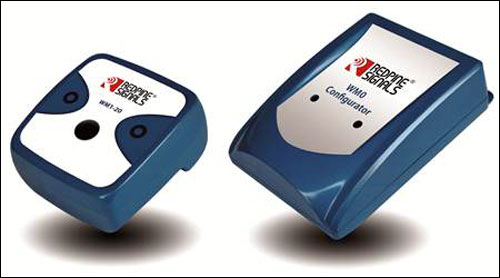Apr. 17, 2012—San Jose wireless systems company Redpine Signals has developed what it says is the first dual-band real-time location system (RTLS) tag that can transmit at the 2.4 GHz or 5 GHz ISM bands over a Wi-Fi network. The tag receives a transmission from an exciter, known as a WM0 Configurator, and then transmits its own identifier, along with that of the configurator, to the nearest Wi-Fi node. The company’s dual-band WM1-50 tag can transmit not only at 2.4 GHz, but also at 5 GHz, complying with the IEEE 802.11a Wi-Fi standard. Redpine Signals also offers the WiseMote WM1-20 tag, which transmits only at 2.4 GHz. Both tags are commercially available now.
The WiseMote WM1-50 tag is designed to address the crowding of data that can occur at the 2.4 GHz channel. Most wireless local area networks (WLANs) currently operate at 2.4 GHz, as specified by the 802.11b/g/n standards. Typically, Wi-Fi tags are dormant for certain lengths of time, in order to spare battery life, and then send transmissions at specified intervals. Due to the crowding of the 2.4 GHz band, tags must, at times, continually resend those transmissions until they are successfully received, thereby shortening a tag’s battery life. With a 5 GHz transmission, there is usually little traffic from other devices attempting to send signals via a Wi-Fi connection. This, according to Redpine, enables a higher quality of service for throughput- or latency-sensitive applications (see Migrating to the 5 GHz Wi-Fi Band Will Advance RTLS and M2M Communications).
Whether transmitting at 2.4 GHz or 5 GHz, the WiseMote WM1-50 tag is first activated via a 125 kHz signal from the configurator. Alternately, the tag can be programmed either at the factory or by a user (via the configurator) to beacon at specific intervals. It then transmits that configurator’s ID number, as well as its own unique identifier, to a Wi-Fi node. By using the configurator, a user can program the tag for beaconing rates, in addition to awakening it at such locations as a doorway or other portal.
The WiseMote WM1-50 tag can use the Cisco Compatible Extensions (CCX) mode to transmit data to Cisco Systems Wi-Fi nodes, as well as to other Wi-Fi network-access devices. The tag also comes with a programmable alarm button that a tag user can press in order to issue an alert along with its transmissions, as well as two LED lights—one to indicate battery function, and the other to signify that the tag is in an active state—a battery with a lifespan of more than five years (if beaconing every three minutes), and a motion detector that the tag can use to transmit movement-related data, if so programmed.
The WiseMote WM1-20 (2.4 GHz) and WM1-50 (dual 2.4 GHz and 5 GHz) 802.11n Wi-Fi RTLS tags work with any third-party standards-based Wi-Fi hardware and software RTLS infrastructure, says Venkat Mattela. Redpine Signals’ CEO.
The technology was developed by Redpine, Mattela says, after the company worked for the past three years to design an advanced Wi-Fi tag that could transmit an ID to Cisco nodes. The dual-mode tag was developed to address future growth in 2.4 GHz transmissions, he adds, with expectations that the 2.4 GHz band will become increasingly crowded, particularly in such markets as health care, in which hospitals utilize Wi-Fi transmission for multiple types of data.
As the 2.4 GHz band becomes crowded, the quality of data transfer decreases and network coverage areas sometimes need to be reduced in order to accommodate the larger numbers of devices operating within the network. The “2.45 [GHz band] is very crowded, as more and more devices are competing for bandwidth,” says Michael Liard, VDC Research Group’s director of RFID. Other technology providers, he adds, are looking into 5 GHz tags for applications such as toll collection on European highways.
However, not all providers of Wi-Fi-based RFID tags are doing so.
“We’re focused on delivering solutions and services to our more than 800 customers. We’re always listening to customer and prospect demand to prioritize our offerings, and at this time, we don’t see demand for a 5 GHz tag,” says Steffan Haithcox, AeroScout’s associate VP of marketing. AeroScout tags typically beacon small (412-bit) packets that are received by multiple access points, and therefore, he argues, there is little difference whether the transmission is 2.4 GHz or 5 GHz.
For its part, Redpine notes that the data packets transmitted by its tags are similarly small, and that even the transmission of small packets can become delayed if the RF band is overcrowded.
Redpine Signals is providing its dual-band tag as part of a demonstration kit that includes four WiseMote tags, as well as a WM0 Configurator that acts as an exciter for those tags, forwarding tag data to a back-end system via a Wi-Fi or Ethernet connection. While the firm offers demonstration software, it expects integrators to provide users with software to manage the tag-read data. The demo software includes a Microsoft Windows- and Linux-compatible application with a configuration utility, along with an Android application for tag detection. The kit also comes with a USB cable for the configurator.
According to Mattela, the solution can be employed for tracking assets within logistics and warehousing facilities; medical applications, such as patient tracking, access control, monitoring transportation conditions via temperature, shock or humidity sensors, tracking goods within shipping yards, performing inventory counts, and monitoring equipment security.
The tag measures 20 millimeters by 17.5 millimeters (0.8 inch by 0.7 inch). The kit costs $5,000, with tags priced at approximately $50 apiece.
WiseMote tags are designed as much for machine-to-machine (M2M) applications as for RTLS. The tags also comes with Wi-Fi Direct (a peer-to-peer specification published by the Wi-Fi Alliance), allowing Wi-Fi-enabled devices to connect with each other without requiring a Wi-Fi node. A number of mobile devices, including smartphones, laptop and notebook computers, cameras, printers and portable gaming systems (such as the Nintendo DSi and Sony PSP platforms) support Wi-Fi Direct, though Redpine expects that most Wi-Fi Direct applications will likely focus on utilizing phones and laptop computers to read Redpine’s tags. Smartphones, such as Android devices and Apple iPhones that can support Wi-Fi connectivity, can receive data from a WiseMote tag upon coming within transmission range of that tag. No special software would be necessary to accomplish this, Mattela says, adding that this peer-to-peer communication between a tag and a smartphone (or other mobile device) would not pose a security risk, since Redpine’s “tag supports enterprise security as well, for regular transfers.”
The WiseMote dual-band tag was released this month, and is commercially available now.



